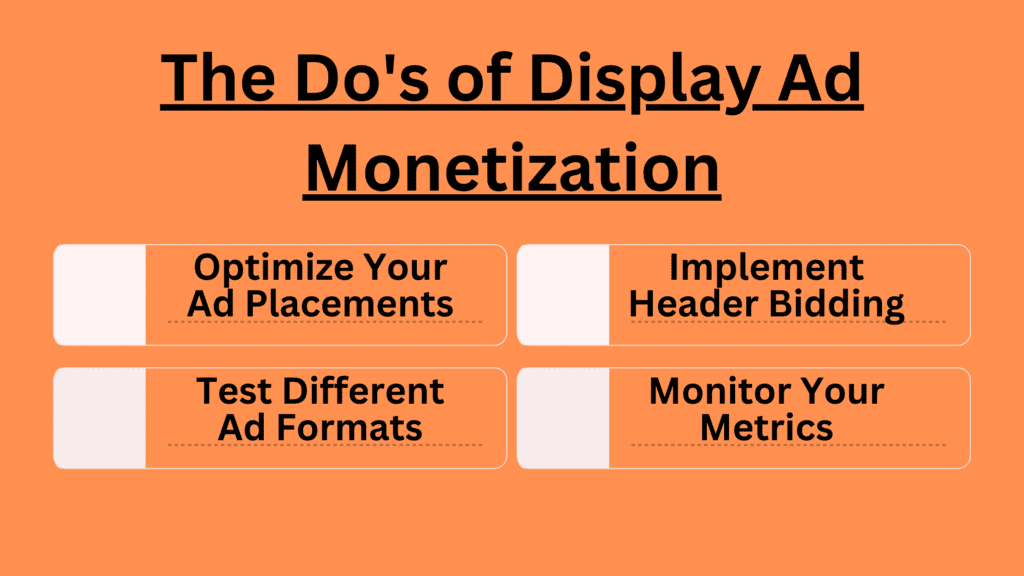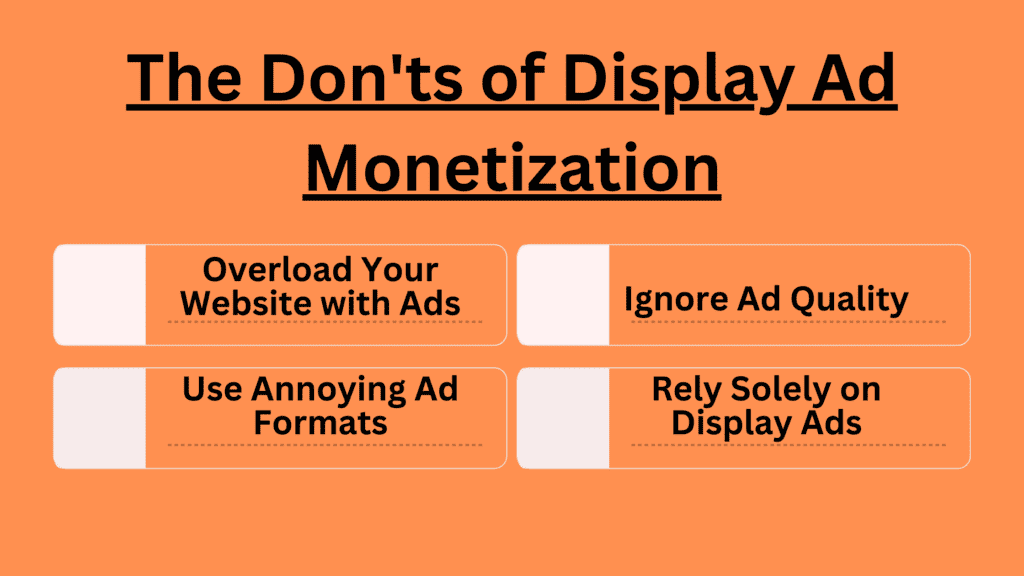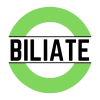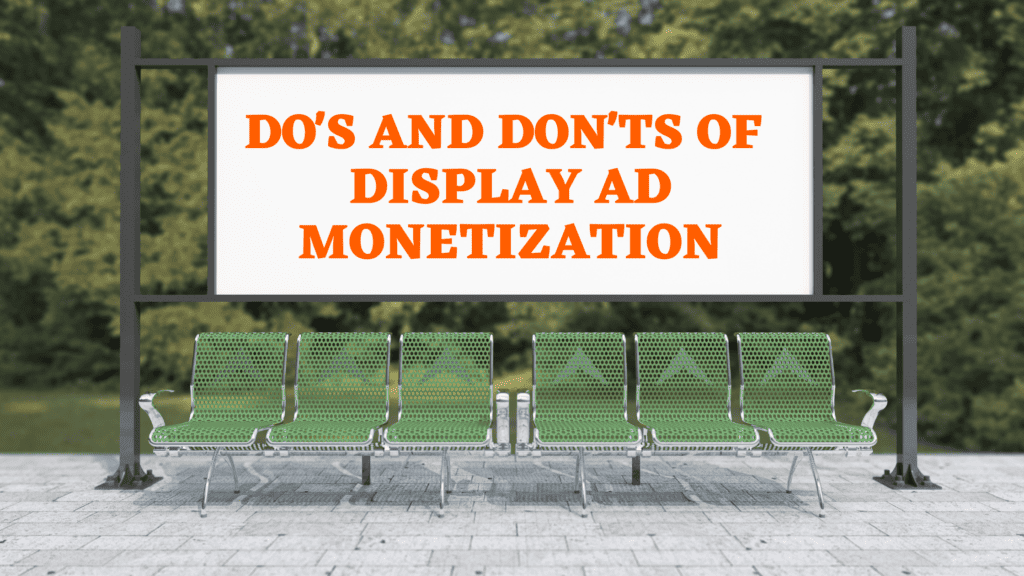If you’re looking to monetize your website through display advertising, you may be wondering what the best practices are for maximizing your revenue through display ad monetization, as they are the most common and best way to monetize online.
While there are several strategies you can employ to increase your earnings, there are also some common mistakes that publishers make that can hinder their success.
In this article, we’ll explore the do’s and don’ts of display ad monetization, so you can make the most of your advertising efforts and boost your ad revenue.
Understanding Display Ad Monetization
Before we dive into the do’s and don’ts of display ad monetization, it’s important to understand what it is and how it works. Display ad monetization refers to the process of earning revenue by displaying ads on your website.

When someone clicks on an ad, you earn a portion of the revenue generated by that click, as a publisher of the ad. The more traffic your website receives, the more potential revenue you can earn through display ads.
The opposite happens with advertisers who pay for each click or impression (CPC or CPM). And we can say, that’s how the ads industry works for the web part, which is quite huge.
There are several types of display ads, including banner ads, native ads, and video ads (and much more).
Banner ads are the most common type of display ad and are typically displayed at the top or bottom of a webpage. Native ads blend in with the content of a webpage, while video ads are displayed within a video player.
You can learn more about the different types of display ads and how do they work here.
The Do’s of Display Ad Monetization

To make the most of your display ad monetization efforts, there are several best practices you should follow. Here are some of the most important do’s of display ad monetization:
Do: Optimize Your Ad Placements
One of the most important factors in display ad monetization is ad placement. You want to make sure that your ads are placed in areas where they will be noticed by your audience, without being too obtrusive or annoying.
Some common ad placements include above the fold, in the sidebar, and within the content. By testing different ad placements and analyzing your metrics, you can determine which placements generate the most revenue for your website.
Do: Test Different Ad Formats
Another important factor in display ad monetization is ad format. Different ad formats may perform better or worse depending on your audience and website content.
By testing different ad formats, such as banner ads, native ads, and video ads, you can determine which formats generate the most revenue for your website.
Do: Implement Header Bidding
Header bidding is a technique that allows publishers to offer their ad inventory to multiple ad exchanges simultaneously.
This can increase competition for your ad inventory, leading to higher bids and increased revenue. On Implementing header bidding, you can maximize your revenue potential and earn more from your display ads.
Do: Monitor Your Metrics
To optimize your display ad monetization efforts, it’s important to regularly monitor your metrics. Some important metrics to track include click-through rate (CTR), cost per click (CPC), and revenue per thousand impressions (RPM).
Analyzing these metrics will help you identify areas where you can improve your display ad performance and increase your revenue.
Consider this as a step process as I have designed here with DOs subtitles, and follow it to get better with display ads.
Now let’s take a look into what to avoid…
The Don’ts of Display Ad Monetization

While there are several best practices to follow when it comes to display ad monetization, there are also some common mistakes that publishers make that can hurt their revenue potential.
Here are some of the most important don’ts of display ad monetization:
Don’t: Overload Your Website with Ads
While it may be tempting to add as many ads as possible to your website in order to increase revenue, overloading your website with ads can actually hurt your revenue potential.
Too many ads can make your website look cluttered and overwhelming, leading to a poor user experience. Additionally, Google may penalize websites that display too many ads, which can hurt your search rankings and traffic.
Don’t: Use Annoying Ad Formats
Certain ad formats, such as pop-ups and auto-play video ads, can be annoying to users and can hurt your website’s user experience.
While these ad formats may generate more revenue in the short term, they can lead to increased bounce rates and decreased engagement, which can hurt your revenue potential in the long run. Instead, focus on using ad formats that are less obtrusive and more user-friendly.
Don’t: Ignore Ad Quality
The quality of the ads you display on your website can have a significant impact on your revenue potential. Low-quality ads, such as those that are irrelevant, misleading, or offensive, can turn off your audience and hurt your credibility.
Additionally, Google may penalize websites that display low-quality ads, which can hurt your search rankings and traffic. To maximize your revenue potential, focus on displaying high-quality ads that are relevant and engaging to your audience.
Don’t: Rely Solely on Display Ads
While display ad monetization can be a lucrative revenue stream for publishers, it’s important not to rely solely on display ads. Diversifying your revenue streams can help you mitigate risk and ensure long-term sustainability.
Consider other monetization strategies, such as affiliate marketing, sponsored content, and subscription models, in order to maximize your revenue potential.
Conclusion
Display ad monetization can be a great way to earn revenue from your website, but it’s important to follow best practices and avoid common mistakes in order to maximize your earnings.
By optimizing your ad placements, testing different ad formats, implementing header bidding, and monitoring your metrics, you can make the most of your display ad monetization efforts.
Additionally, by avoiding common mistakes such as overloading your website with ads, using annoying ad formats, ignoring ad quality, and relying solely on display ads, you can ensure long-term success and sustainability for your website.
FAQs
How many display ads should I have on my website?
- There is no set number of display ads that you should have on your website. It’s important to find a balance between generating revenue and providing a good user experience. Test different ad placements and formats to find what works best for your website and audience.
What are some high-quality ad networks to use for display ad monetization?
- Some popular ad networks for display ad monetization include Google AdSense, AdThrive, Mediavine, and Ezoic. Do your research and test different networks to find the one that works best for your website.
How can I increase my RPM?
- To increase your revenue per thousand impressions (RPM), focus on optimizing your ad placements and formats, implementing header bidding, and displaying high-quality ads that are relevant and engaging to your audience. Additionally, consider diversifying your revenue streams to mitigate risk and maximize your earnings.
Can too many ads hurt my website’s SEO?
- Yes, overloading your website with ads can hurt your search rankings and traffic. Google may penalize websites that display too many ads, so it’s important to find a balance between generating revenue and providing a good user experience.
What are some alternative monetization strategies to display ads?
- Some alternative monetization strategies to display ads include affiliate marketing, sponsored content, and subscription models. Affiliate marketing involves promoting other companies products or services and earning a commission for each sale that is made through your referral. Sponsored content involves partnering with brands to create content that promotes their products or services. Subscription models involve offering exclusive content or features to users who pay a recurring fee. By diversifying your revenue streams, you can maximize your earnings and ensure long-term sustainability for your website.
Additional Resources on Display Ads Monetization
Thanks for reading this article. I hope you got some good tips on display ads monetization.
Here are some referral articles for you if you wanna learn more about monetization and especially display/banner ads monetization:
- How to monetize your website with Display / Banner Ads?
- Google AdSense – Earn Money From Website Monetization
- How to monetize your website?
Comment below your thoughts, opinions, or doubts you wanna share. Would love to read them and will reply to you by the latest.


Good job Ayoosh. Not overloading your blog with ads keeps a pleasing user experience and maximizes earnings; happy readers stick around and either click ads or grow referral business by sharing blog posts with their friends and followers.
Ryan